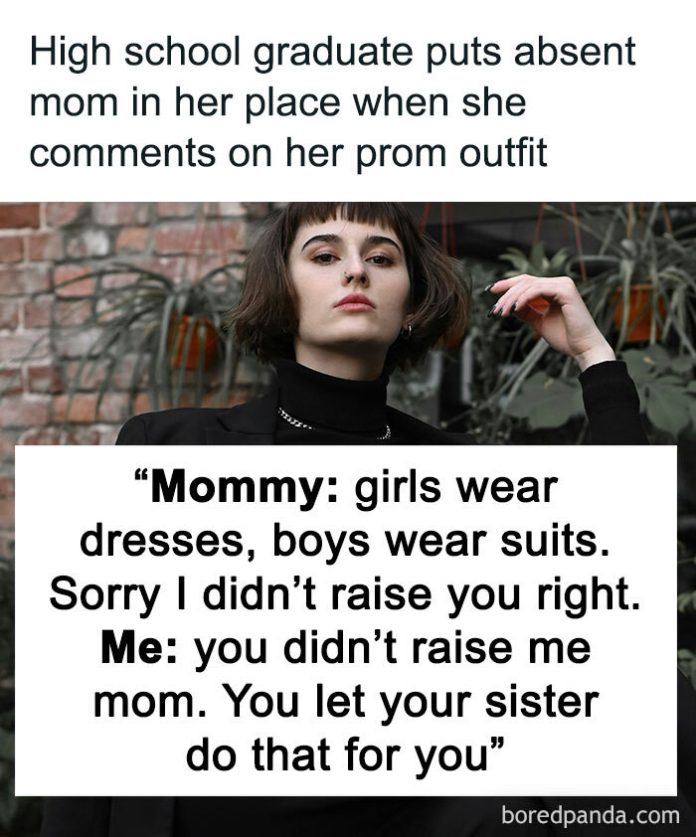In contemporary society, fashion serves as a powerful medium for self-expression, allowing individuals to convey their identities, beliefs, and personalities. However, traditional norms and generational differences can sometimes lead to conflicts, especially within families. A poignant example of this is a recent incident where a young woman chose to wear a suit to her prom, challenging conventional expectations and facing criticism from her mother.
Breaking Traditional Gender Norms in Fashion
Historically, fashion has been delineated along gender lines, with specific attire deemed appropriate for men and women. Dresses and gowns have traditionally been associated with femininity, while suits and trousers have been symbols of masculinity. However, as societal understanding of gender becomes more fluid, these sartorial boundaries are increasingly being questioned and redefined.

The young woman’s decision to wear a suit to her prom exemplifies this shift. By opting for attire traditionally reserved for men, she not only expressed her personal style but also made a statement about gender norms and individuality. Such choices are becoming more common, reflecting a broader movement towards inclusivity and the dismantling of rigid gender binaries in fashion.
Maternal Criticism and Generational Perspectives
Despite the progressive nature of her choice, the young woman faced disapproval from her mother, who believed that wearing a suit was inappropriate for prom. This reaction underscores the generational divide in perceptions of gender-appropriate clothing. For many in older generations, traditional gender roles and associated attire are deeply ingrained, making deviations from these norms appear unconventional or even unacceptable.
The mother’s critique highlights how personal insecurities and societal conditioning can influence one’s acceptance of non-traditional choices. It’s possible that her disapproval stemmed from internalized beliefs about femininity and societal expectations, reflecting a broader issue where parents project their own insecurities onto their children.
The Impact of Parental Comments on Youth
Parental opinions significantly influence a child’s self-esteem and identity formation. Supportive and accepting parents can foster confidence and individuality, while critical or judgmental attitudes may lead to self-doubt and conformity.
In this case, the mother’s negative reaction could have discouraged her daughter from expressing her true self. However, the young woman’s resilience and confidence enabled her to stand by her fashion choice, demonstrating the importance of self-assurance in the face of criticism.
The Role of Fashion as Self-Expression
Fashion is more than just clothing; it’s a form of communication that conveys one’s identity, beliefs, and emotions. For many, choosing what to wear is an intimate act of self-expression, allowing them to navigate and challenge societal norms.
By wearing a suit to prom, the young woman utilized fashion to express her individuality and challenge traditional gender norms. Such acts can inspire others to embrace their authentic selves, fostering a culture that values diversity and personal expression.
Support from Online Communities
The incident garnered attention online, with many praising the young woman’s courage and criticizing the mother’s outdated views. Online platforms can serve as supportive communities where individuals share experiences and receive validation, especially when facing criticism in their personal lives.
This support highlights a societal shift towards acceptance and celebration of individuality. As more people challenge traditional norms, these online communities play a crucial role in providing encouragement and fostering inclusive dialogues.

Encouraging Open Dialogue Between Generations
The generational clash depicted in this scenario emphasizes the need for open conversations about evolving societal norms. Parents and children may hold differing views due to the eras they were raised in, but respectful dialogue can bridge these gaps.
By discussing topics like gender norms and self-expression, families can foster understanding and acceptance. Such conversations can help dismantle outdated beliefs and promote a more inclusive environment for future generations.
Conclusion
The young woman’s choice to wear a suit to her prom serves as a microcosm of the broader societal shifts regarding gender norms and self-expression. While facing criticism from traditional viewpoints, her stance reflects a growing movement towards individuality and the rejection of rigid gender binaries.
This incident underscores the importance of supporting personal choices and embracing diversity. As society continues to evolve, fostering environments that celebrate individuality and challenge outdated norms will lead to a more inclusive and accepting world.

















